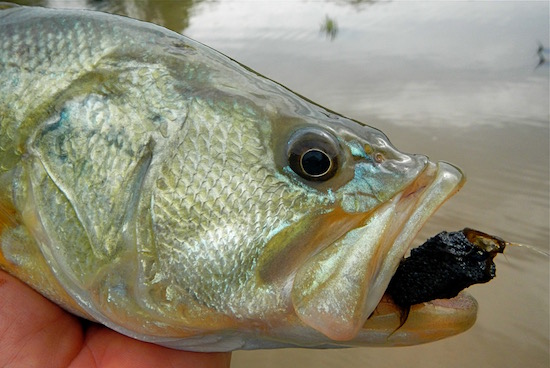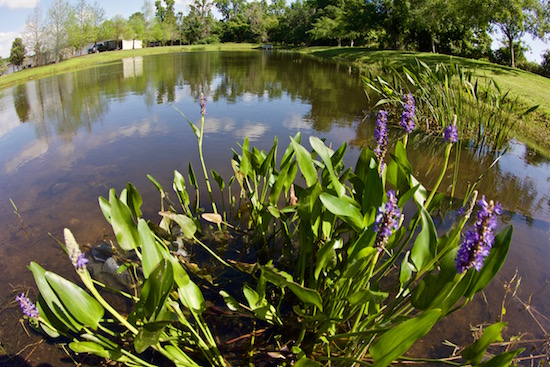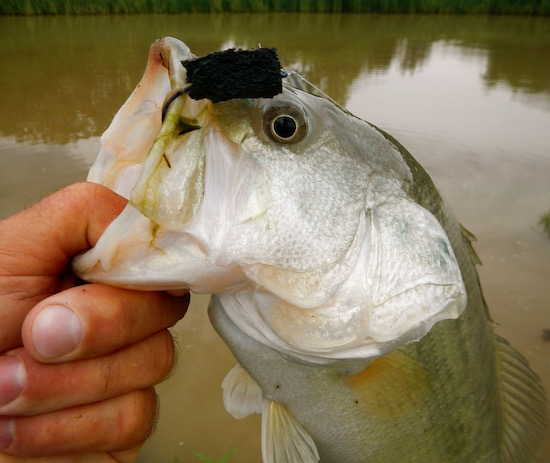 Fly Fishing Florida Retention Ponds
Fly Fishing Florida Retention Ponds
This article is about fly fishing Florida retention ponds for bass and sunfish.
One of the features of fly fishing in the midwest is the farm pond. One of the features of freshwater fly fishing here in Florida is the lowly retention pond, a mostly ignored resource. Lawn and street yuck drain into a hole that was dug in some neighborhood so the dirty water has a chance to clean up before moving into the local watershed. In spite of that yuck, fish live in them. Fish must be pretty adaptable creatures. Because not many folks fish retention ponds, the fish that live in them tend to be unsophisticated and aggressive. I like my fish that way!
Basically, any pond that doesn’t dry up and isn’t completely choked with vegetation has the potential to produce fish- bass, sunfish, tilapia (haven’t caught one yet myself), carp. Bass and sunfish are what I’ve been targeting. My son Alex has been trying to get a carp. I can’t claim to be a retention pond expert, but have noticed some trends and figured out enough to recommend these ubiquitous Florida landscape features to other anglers.
Ponds To Avoid
You will want to avoid some ponds. If they have a No Trespassing sign, a No Fishing sign (I really dislike those two signs!), or are enclosed by a fence, you probably don’t want to fish there. If you can jump across it it’s probably too small.
I avoid ponds where I see other people fishing. I don’t like to fish ponds where I find discarded plastic worms, fish hook packaging, balls of fishing line, or other fishing-related litter. Since these ponds tend to be small, it doesn’t take much fishing pressure to ruin them. Some people avoid ponds with alligators, although they don’t bother me much. Whether to fish a pond with either of these scenarios would be your call.
Signs That Indicate The Presence of Fish
There are certain things I want to see in a pond. Rooted, emergent vegetation like bulrushes, cattails, water lilies, or pickerelweed means the pond has been there a while, so may hold fish. Minnows such as guppies around the margins of the pond are a good sign. Wading birds or cormorants are a really good sign. And of course, actually seeing some fish in the pond is a really, really good sign.
I always like clean water but it is not necessary. I’ve gotten some nice bass from ponds with pretty murky water.
The Approach
My approach is simple and straightforward. After a quick initial survey to get a feel for whether or not I think the pond will hold fish, I just walk up to a pond with the rod in my hand and start casting. The fly line will float. The fly may also float (I like deerhair bugs), although I (and the bass) like a black matuka too.
I get more bites near the edges than out in the middle. I work pretty fast, making and fishing a cast, moving a few feet, and repeating. My son Alex claims he gets bigger fish by fishing the fly slowly, a technique I need to try. While the 12 to 14 inch fish are sporty, a five pounder would be awesome! And many retention ponds do produce sizeable fish.
Some ponds don’t produce. Unless there’s a compelling reason I generally don’t return to those. Those ponds to which I do return I try to rest at least a week between visits. Since these ponds tend to be small, it doesn’t take much fishing pressure to ruin them. Alex has noticed behavioral changes in the fish in ponds he and his friends have fished too frequently. The fish smarten up pretty quickly.
The best way to approach these ponds is to find more than you think you need, and rotate between them. That way they all stay fresh, with happy, dumb fish.
Tilapia
Alex says the way to catch tilapia, a fish that only eats algae, is to cast your fly into the bed the fish makes on the bottom. Leave the fly there until the fish picks it up to move it off the bed, then set the hook.
Apparently some patience is needed to use this technique, since the fish frequently spooks off the bed when you cast to it. Alex says just leave it there for as long as it takes (several minutes sometimes) for the fish to pick it up to move it.
What to Do with Your Catch
Release unharmed all the fish you catch from retention ponds. Do not eat them for the sake of your own health. Pesticides, herbicides, tire and brake dust, automobile fluids, and who-knows-what-else all wash directly into these ponds from lawns and storm drains- that’s what they were designed and built for!
That having been said, every fish I have caught from retention ponds has been chunky and healthy. In spite of the questionable water quality they seem to be fine. Still, it doesn’t seem like a good idea to eat them.
Besides, don’t you want them to be there when you come back next time?
Now that you know about fly fishing Florida retention ponds for bass and sunfish, get out there and catch some fish!
John Kumiski
www.spottedtail.com
http://www.spottedtail.com/blog
www.johnkumiski.com
www.rentafishingbuddy.com
https://www.smashwords.com/profile/view/jkumiski
All content in this blog, including writing and photos, copyright John Kumiski 2022. All rights are reserved.


